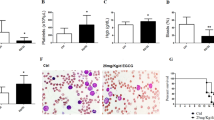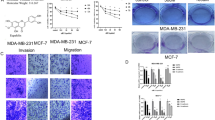Abstract
Green tea constituent (−) epigallocatechin-3-gallate (EGCG) has shown remarkable cancer-preventive and some cancer-therapeutic effects. This is partially because of its ability to induce apoptosis in cancer cells without affecting normal cells. Previous studies from our laboratory have shown the involvement of NF-κB pathway in EGCG-mediated cell-cycle deregulation and apoptosis of human epidermoid carcinoma A431 cells. Here we show the essential role of caspases in EGCG-mediated inhibition of NF-κB and its subsequent apoptosis. Treatment of A431 cells with EGCG (10–40 μg/ml) resulted in dose-dependent inhibition of NF-κB/p65, induction of DNA breaks, cleavage of poly(ADP-ribose) polymerase (PARP) and morphological changes consistent with apoptosis. EGCG treatment of cells also resulted in significant activation of caspases, as shown by the dose- and time-dependent increase in DEVDase activity, and protein expression of caspase-3, -8 and -9. EGCG-mediated caspase activation induces proteolytic cleavage of NF-κB/p65 subunit, leading to the loss of transactivation domains, and driving the cells towards apoptosis. EGCG-mediated induction of apoptosis was significantly blocked by the caspase inhibitor N-benzyloxycarbonyl-Val-Ala-Asp(OMe)-fluoromethylketone (Z-VAD-FMK), and moderately blocked by the specific caspase-3 inhibitor Z-DEVD-FMK. Further, pretreatment of cells with Z-VAD-FMK was found to suppress the cleavage of NF-κB/p65 subunit, thereby increasing nuclear translocation, DNA binding and transcriptional activity, thus protecting the cells from EGCG-induced apoptosis. Taken together, these studies for the first time demonstrate that EGCG-mediated activation of caspases is critical, at least in part, for inhibition of NF-κB and subsequent apoptosis.
This is a preview of subscription content, access via your institution
Access options
Subscribe to this journal
Receive 50 print issues and online access
$259.00 per year
only $5.18 per issue
Buy this article
- Purchase on Springer Link
- Instant access to full article PDF
Prices may be subject to local taxes which are calculated during checkout













Similar content being viewed by others
Abbreviations
- EGCG:
-
(−)-epigallocatechin-3-gallate
- NF-κB:
-
nuclear factor-kappaB
- PARP:
-
poly(ADP-ribose) polymerase
- Z-VAD-FMK:
-
N-benzyloxycarbonyl-Val-Ala-Asp(OMe)-fluoromethylketone
- Z-DEVD-FMK:
-
CPP32/apopain inhibitor
References
Aggarwal BB . (2000). Biochem. Pharmacol., 60, 1033–1039.
Ahmad N, Feyes DK, Nieminen AL, Agarwal R and Mukhtar H . (1997). J. Natl. Cancer Inst., 89, 1881–1886.
Ahmad N, Gupta S and Mukhtar H . (2000). Arch. Biochem. Biophys., 376, 338–346.
Bours V, Bentires-Alj M, Hellin AC, Viatour P, Robe P, Delhalle S, Benoit V and Merville MP . (2000). Biochem. Pharmacol., 60, 1085–1089.
Chen ZP, Schell JB, Ho CT and Chen KY . (1998). Cancer Lett., 129, 173–179.
Cheng EH, Kirsch DG, Clem RJ, Ravi R, Kastan MB, Bedi A, Ueno K and Hardwick JM . (1997). Science, 278, 1966–1968.
Chung JH, Han JH, Hwang EJ, Seo JY, Cho KH, Kim KH, Youn JI and Eun HC . (2003). FASEB J., 17, 1913–1915.
Chung LY, Cheung TC, Kong SK, Fung KP, Choy YM, Chan ZY and Kwok TT . (2001). Life Sci., 68, 1207–1214.
Clem RJ, Cheng EH, Karp CL, Kirsch DG, Ueno K, Takahashi A, Kastan MB, Griffin DE, Earnshaw WC, Veliuona MA and Hardwick JM . (1998). Proc. Natl. Acad. Sci. USA, 95, 554–559.
Clement MV, Hirpara JL, Chawdhury SH and Pervaiz S . (1998). Blood, 92, 996–1002.
Ferreira CG, Epping M, Kruyt FA and Giaccone G . (2002). Clin. Cancer Res., 8, 2024–2034.
Green D and Kroemer G . (1998). Trends Cell Biol., 8, 267–271.
Grutter MG . (2000). Curr. Opin. Struct. Biol., 10, 649–655.
Gupta S, Ahmad N, Nieminen AL and Mukhtar H . (2000). Toxicol. Appl. Pharmacol., 164, 82–90.
Gupta S, Hussain T and Mukhtar H . (2003). Arch. Biochem. Biophys., 410, 177–185.
Hastak K, Gupta S, Ahmad N, Agarwal MK, Agarwal ML and Mukhtar H . (2003). Oncogene, 22, 4851–4859.
Hayakawa S, Saeki K, Sazuka M, Suzuki Y, Shoji Y, Ohta T, Kaji K, You A and Isemura M . (2001). Biochem. Biophys. Res. Commun., 285, 1102–1106.
Islam S, Islam N, Kermode T, Johnstone B, Mukhtar H, Moskowitz RW, Goldberg VM, Malemud CJ and Haqqi TM . (2000). Biochem. Biophys. Res. Commun., 270, 793–797.
Janicke RU, Walker PA, Lin XY and Porter AG . (1996). EMBO J., 15, 6969–6978.
Joyce D, Albanese C, Steer J, Fu M, Bouzahzah B and Pestell RG . (2001). Cytokine Growth Factor Rev., 12, 73–90.
Karin M and Lin A . (2002). Nat. Immunol., 3, 221–227.
Kim PK, Mahidhara R and Seol DW . (2001). Drug Resist. Updat., 4, 293–296.
Kong AN, Yu R, Hebbar V, Chen C, Owuor E, Hu R, Ee R and Mandlekar S . (2001). Mutat. Res., 480–481, 231–241.
Kuo PL and Lin CC . (2003). J. Biomed. Sci., 10, 219–227.
Lazebnik YA, Takahashi A, Moir RD, Goldman RD, Poirier GG, Kaufmann SH and Earnshaw WC . (1995). Proc. Natl. Acad. Sci. USA, 92, 9042–9046.
Levkau B, Scatena M, Giachelli CM, Ross R and Raines EW . (1999). Nat. Cell Biol., 1, 227–233.
Masuda M, Suzui M and Weinstein IB . (2001). Clin. Cancer Res., 7, 4220–4229.
Nicholson DW . (1999). Cell Death Differ., 6, 1028–1042.
Ravi R, Bedi A, Fuchs EJ and Bedi A . (1998). Cancer Res., 58, 882–886.
Schwartz SA, Hernandez A and Mark Evers B . (1999). Surg. Oncol., 8, 143–153.
Singh AK, Seth P, Anthony P, Husain MM, Madhavan S, Mukhtar H and Maheshwari RK . (2002). Arch. Biochem. Biophys., 401, 29–37.
Stennicke HR and Salvesen GS . (2000). Biochim. Biophys. Acta, 1477, 299–306.
Surh YJ, Chun KS, Cha HH, Han SS, Keum YS, Park KK and Lee SS . (2001). Mutat. Res., 480–481, 243–268.
Tang D and Kidd VJ . (1998). J. Biol. Chem., 273, 28549–28552.
Tewari M, Quan LT, O'Rourke K, Desnoyers S, Zeng Z, Beidler DR, Poirier GG, Salvesen GS and Dixit VM . (1995). Cell, 81, 801–809.
Wang C-Y, Mayo MW and Baldwin Jr AS . (1996). Science, 274, 784.
Wu M, Lee H, Bellas RE, Schauer SL, Arsura M, Katz D, FitzGerald MJ, Rothstein TL, Sherr DH and Sonenshein GE . (1996). EMBO J., 15, 4682–4690.
Yamamoto Y and Gaynor RB . (2001). J. Clin. Invest., 107, 135–142.
Yang GY, Liao J, Kim K, Yurkow EJ and Yang CS . (1998). Carcinogenesis, 19, 611–616.
Yu R, Mandlekar S, Harvey KJ, Ucker DS and Kong AN . (1998). Cancer Res., 58, 402–408.
Zimmermann KC, Bonzon C and Green DR . (2001). Pharmacol. Ther., 92, 57–70.
Acknowledgements
This work was supported by grants from United States Public Health Service (RO1CA 78809), American Institute for Cancer Research (00A030) and Department of Defense (DAMD 17-00-1-0527). Sanjay Gupta, PhD is grateful to the ‘Cancer Research Foundation of America’ and ‘The O-CHA (Tea) Pioneer Academic Research Grant Program’, Japan, for a partial support of funds.
Author information
Authors and Affiliations
Corresponding author
Rights and permissions
About this article
Cite this article
Gupta, S., Hastak, K., Afaq, F. et al. Essential role of caspases in epigallocatechin-3-gallate-mediated inhibition of nuclear factor kappaB and induction of apoptosis. Oncogene 23, 2507–2522 (2004). https://doi.org/10.1038/sj.onc.1207353
Received:
Revised:
Accepted:
Published:
Issue Date:
DOI: https://doi.org/10.1038/sj.onc.1207353
Keywords
This article is cited by
-
The NF-κB signalling pathway and TM7SF3 contribute to liver fibrosis caused by secreted phospholipase A2 of Clonorchis sinensis
Parasites & Vectors (2021)
-
Arsenic-induced uterine apoptotic damage is protected by ethyl acetate fraction of Camellia sinensis (green tea) via Bcl-2-BAX through NF-κB regulations in Wistar rats
Environmental Science and Pollution Research (2021)
-
Effects of nutraceuticals on anaplastic thyroid cancer cells
Journal of Cancer Research and Clinical Oncology (2018)
-
In vitro and in vivo study of epigallocatechin-3-gallate-induced apoptosis in aerobic glycolytic hepatocellular carcinoma cells involving inhibition of phosphofructokinase activity
Scientific Reports (2016)



